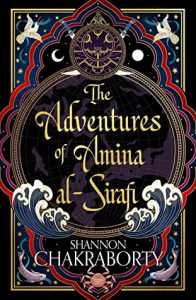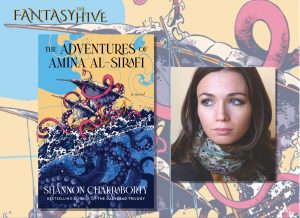Interview with Shannon Chakraborty (THE ADVENTURES OF AMINA AL-SIRAFI)
Shannon Chakraborty is the author of the critically acclaimed and internationally best-selling The Daevabad Trilogy. Her work has been translated into over a dozen languages and nominated for the Hugo, Locus, World Fantasy, Crawford, and Astounding awards. When not buried in books about medieval seafarers and con artists, she enjoys hiking, knitting, and re-creating unnecessarily complicated historical dishes. You can find her online at www.sachakraborty.com or on Twitter and Instagram at @SAChakrabooks, where she likes to talk about history, politics, and Islamic art. She currently lives in New Jersey with her husband, daughter, and an ever-increasing number of cats.
Welcome back to the Hive Shannon!
First of all, congratulations on the release of your brand-new, much-anticipated fantasy The Adventures of Amina al-Sirafi! Can you tell our readers a little about what they can expect?
Thank you! The story follows the escapades of a former pirate and ship’s captain, the eponymous Amina al-Sirafi, when she’s pulled out of retirement and hired to track down the kidnapped daughter of a late comrade. Offered a fortune and a righteous cause, Amina seizes on the chance to have her “one last adventure.” But she no sooner starts getting her gang back together, then it becomes pretty clear the assignment is both more dangerous and more supernatural than they expected. For their foe, an ex-Crusader who’s left the holy wars raging in the north, is seeking not only magic in their lands—but Amina herself.
I wrote it as the sort of book I’ve been craving in the past few years: a madcap adventure tale that offers excitement and escapism, but also a good dose of heart. It touches upon plenty of serious topics: class and societal oppression, the struggle to balance parenthood and your dreams, and perhaps most obviously, the “crafting” of history and one’s legacy. But it’s also a story about a deeply flawed woman who finds faith and family in later life, about clinging to humor and hope even in the bleakest of circumstances.
Just for fun, can you describe your book in five words?
Sindbad the Sailor meets Ocean’s 11 (in the spirit of the book, I’m cheating and deciding 11 doesn’t count as a word)
We’ll allow it. But only because it’s you!

You recreate the world so vividly and with such authority, the reader feels transported – tell us about your research. What was one of the most interesting things your research uncovered?
Easily one of the most enjoyable topics to research was criminal activity—specifically overwrought stories and urban legends about criminal activity—in the medieval world. All the cons, tricks, and poisons in this book are pulled from history: there’s actually a thirteenth century charlatan’s guide (recently translated into English by the Library of Arabic Literature) which discusses both the three cups game still used to swindle gullible tourists today and the numerous knock-out drugs Dalila employs. The guild Dalila hails from—the Banu Sasan—was also real, or as “real” as the fantastical odes recited about it were. Not only were these entertaining accounts to read on their own, I also loved how consistently such research brought the past alive: people today are still obsessed with stories of true crime and it really brought home how little some of our media has changed! I also stumbled across rather detailed instructions on how to make a knock-out gas that you quite literally release by making the grade school armpit farting noise with your hand so if anyone’s kids are looking for new pranks…
What was your approach to combining this research and the historical setting with your elements of the more fantastic and the mythology of the Middle East?
My original goal for this novel was to have the setting be as historically accurate as possible with only the plot and magical details invented…which was an excellent way to end up both repeatedly humbled and reminded of the slippery malleability of the past. Hilary Mantel famously said once that “history is not the past. It is what is left in the sieve when the centuries have run through it.” Except of course the centuries have not run unobjectively through it; history is the creation of those who tell it with all their unconscious biases and outright intentions.
What I tried for then was for the book to be as historically plausible as was possible, however it’s also meant to be in conversation with the travelogues and “wonder literature” that were popular in the medieval Islamicate world. But I wanted to center on the people who got talked about, rather than traditionally did the telling: the sailors and porters who carried these scholars, the local women made into scandalous gossip, the “criminals” and pirates often pushed to the sidelines or made into villains. And I wanted it to be funny! Too often we associate the medieval world with grim visions of dark, dirty castles and constant misogyny. These people had colorful lives and the historical accounts they leave are often hysterical and entertaining.
Honestly after all that, adding the fantastic elements was fairly easy. As in much of the world at this time, what we would today call “magic” was often considered quite real and bringing to life both the menace and awe of a magical realm these characters would have very much feared as it slowly engulfs them was one of the most satisfying parts of crafting the story.

Let’s discuss your characters! What inspired Amina’s gutsy, strong and capable character?
I feel like Amina has been whispering in my mind for several years now. For one, I knew I wanted my next project to focus on an “older” (I am not far from her age so I’ll confess this feels strange to say!) female character, specifically someone who was a mother. Not only is there an unfortunate dearth of both older female characters and mothers in science fiction and fantasy, I also think the tension and challenge of balancing parenthood and one’s career and outside passions—let alone the responsibilities of keeping said offspring housed, fed, nurtured, and loved—is something we don’t see mirrored enough, even though it’s what life looks like for most of the people I know. But I didn’t want this to simply be a medieval spin on the impossibility of “having it all,” I wanted it to be fun. History is rarely kind to women and I don’t want to sugar coat that fact, but I also fear so frequently presenting the past as a constant misery in fiction is its own unconscious misogyny. Women have always made lives for themselves and found JOY in those lives. I was also very tired with the popular perception of Muslim women cloistered away for centuries when as soon as you dive into the history, you find richer lives of chaotic divorcees and thieves and scheming queens and educated scholars. Amina sprang from all of that. Someone who was flawed and unapologetically ambitious, someone who loved fiercely, could fight viciously, and was still determined to come back to her faith and family.
We absolutely loved Raksh. How much fun did you have creating his character?
Oh, he was an utter delight to write. So many of the characters in this book are coming to terms with past misdeeds or trying stick to a more righteous path and then you have this utterly selfish, sexy creature of chaos and trickery just waltz in and repeatedly betray them to save his own skin and spin “a better story.” And that’s the very point of him—he’s not human, he’s very much meant to be a relic of a forgotten age when people did tell stories of meddling, petty gods and monsters, a supernatural aspect that naturally feeds on human ambition and wouldn’t even understand why he’s expected to feel remorse for doing so. It was fun to create such a foil for Amina herself and really delve into the almost alien psyche of such a being.
You’re completely stranded on a deserted island with just one other person. Between Amina, Dalila, Tinbu or Majed, who would you choose to be stranded with and why?
This is a hard question: they’re meant to work as a team! But the pragmatist in me says that Tinbu has the best shot of building a proper raft out of whatever we can cobble together. We might have no idea where we’re going, but he’s definitely the tinkerer out of the bunch and that seems like a solid survival bonus.
And lastly, can we hope to set sail with Amina again in future? Please say yes!
Absolutely. I’m working on the sequel now and have a final volume on the horizon after that. The second book is still in the early draft stages but I’m aiming for something that feels like a cross between a ghost story and a murder mystery, and one that plunges even deeper into the malleability of the past and who gets to determine what history truly is.
The Adventures of Amina al-Sirafi is out this week! Get your copy here: US | UK


[…] 6: The Adventures of Amina al-Sirafi by Shannon Chakraborty (495 […]
[…] 6: The Adventures of Amina al-Sirafi by Shannon Chakraborty (495 […]
[…] 6: The Adventures of Amina al-Sirafi by Shannon Chakraborty (495 […]
[…] 6: The Adventures of Amina al-Sirafi by Shannon Chakraborty (495 […]